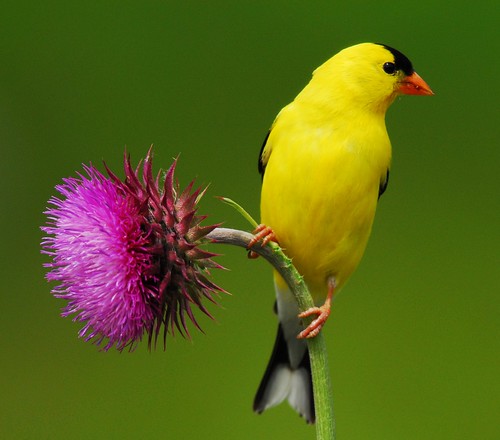

Honorable Mention in Canadian Geographic Wildlife photo of the year contest - Bird Category, originally uploaded by ff151.
My yard lost trees after an ice storm, so I have less shelter available for birds near the feeders. I'd like to construct a brush pile. How should I do this?--Tim Gator, Minneapolis, Minnesota
Brush piles are great additions to wildlife-friendly yards. Well-made brush piles provide temporary and permanent shelter from predators or inclement weather and a source of food and nesting materials to insects, invertebrates, amphibians, small animals, and birds.
In particular, urban yards benefit from brush piles because their habitat structure's multiple layers and diversity of materials is most likely to be missing from manicured or overly simplified environments. Here's how to get started.
Location. The location is important. Isolated piles are less likely to be used. Place them in a corner, along a fence, or near existing shrubs--spots that are appealing to wildlife and unobtrusive to neighbors. Put your pile a couple of yards away from your bird feeders--close enough that birds can take cover from predators, such as hawks, but not so close that cats can hide inside. Also, consider that brush piles can obstruct a bird's view, so don't place them between feeders and locations where predators can lurk.
Building materials. Start with a base of large logs or branches arranged in a square or triangle on the ground or upright like a tepee. Leave gaps in the foundation to allow access to the center of the pile for small animals, but make the gaps small enough so cats can't hide inside to ambush birds.
If you have an assortment of branches to work with, use the hardest woods (like oak or cedar) for support. Put softer woods on the ground, where they will provide lots of food as they decompose.
Don't use treated lumber, painted wood, or other materials that will leach chemicals as they break down, endangering wildlife or contaminating the soil. Have rocks, broken flowerpots, or chunks of concrete lying around? Arrange them in loose piles in the center to provide even more hiding places for small animals such as chipmunks or toads.
Add smaller branches on top of your foundation, crisscrossing them as you build. If the pile has a side that will be exposed to cold winds, add extra branches there for increased protection. As the pile breaks down, keep adding material to the top.
Nest essentials. In spring, I like to add clumps of long grass or plant stems, lengths of string, and twigs that birds use to build nests. Don't add grass clippings, leaves, or other items that will make it harder for birds to access the shelter. They're better off in a compost pile.
Size. A stable, wildlife-friendly brush pile is typically about twice as wide as it is tall. Be mindful of the overall size: Larger piles in urban areas might be attractive to skunks, opossums, or rodents that neighbors might find alarming. As a final touch, plant wildflowers and native vines, such as wild grapes or Virginia creeper, near the margins to make your pile more visually attractive.
After finding cherry seeds in my bird baths over the years, I always thought birds defecated in the water. Then one day I watched a robin regurgitate cherry seeds into the bath. Do other birds do this?--Dwight Kilgore, Lewiston, Idaho
One of two things will happen when birds eat fruit. Either they will crush and consume the seeds; cardinals and many sparrows do this and therefore are considered seed predators. Or birds will eat the fruit pulp and then either regurgitate or pass the seeds, in which case they act as seed dispersers.
Small seeds are typically passed, while large seeds are regurgitated. Which end the seed comes out also depends on the size of the bird, the preference of the species, the number of seeds eaten, and their weight. One benefit of regurgitation is that indigestible material sits in the gut for less time. A bird that is under pressure from a predator or that needs to consume a lot of fruit quickly may regurgitate rather than swallow and pass seeds.
Have a question?
Send it to ask@birdersworld.com or visit www.BirdersWorld.com and look for "Our contributors." Or write to: Birder's World Since You Asked, P.O. Box 1612, Waukesha, WI 53187. Please include your name and address.
[ILLUSTRATION OMITTED]
WHO YOU CALLING YELLOW? This bright yellow Northern Cardinal visited Tom Ruggles's feeder in Zanesville, Ohio, from January to April 2009 and returned in November. A pigment disorder known as xanthochroism is responsible for the bird's yellow feathers. As Julie wrote in August 2003, in xanthochroistic birds, either there is an excessive yellow pigment in the feathers or yellow replaces another color--typically red.
Julie Craves is supervisor of avian research at the Rouge River Bird Observatory at the University of Michigan Dearborn and a research associate at the university's Environmental Interpretive Center.
Source Citation
Craves, Julie. "Since you asked." Birder's World Apr. 2010: 12. Academic OneFile. Web. 20 Mar. 2010.
Document URL
http://find.galegroup.com/gps/infomark.do?&contentSet=IAC-Documents&type=retrieve&tabID=T003&prodId=IPS&docId=A219518465&source=gale&srcprod=AONE&userGroupName=broward29&version=1.0
Gale Document Number:A219518465


No comments:
Post a Comment